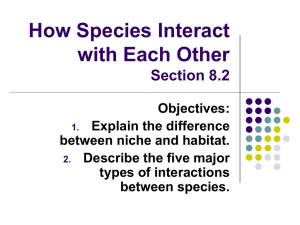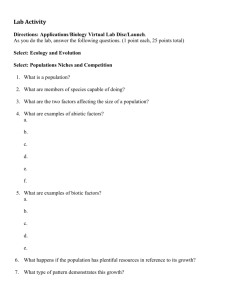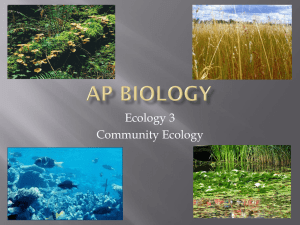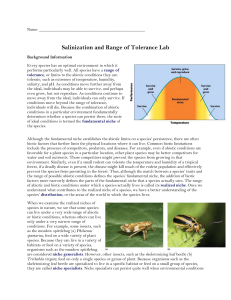Outcomes:
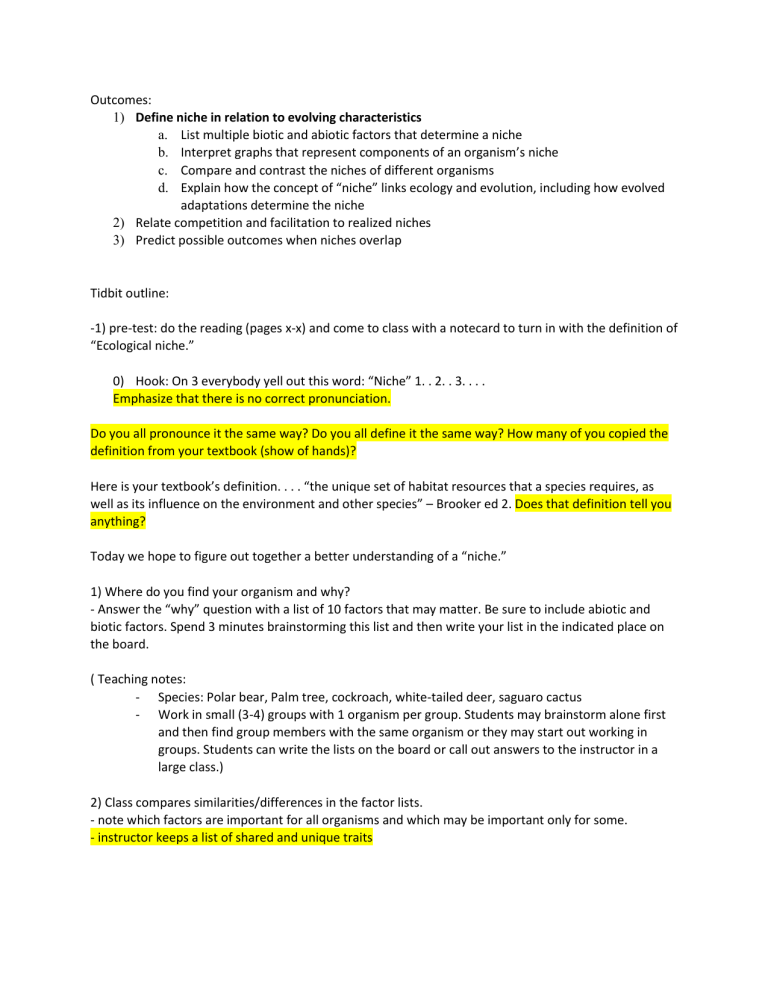
Outcomes:
1) Define niche in relation to evolving characteristics a.
List multiple biotic and abiotic factors that determine a niche b.
Interpret graphs that represent components of an organism’s niche c.
Compare and contrast the niches of different organisms d.
Explain how the concept of “niche” links ecology and evolution, including how evolved adaptations determine the niche
2) Relate competition and facilitation to realized niches
3) Predict possible outcomes when niches overlap
Tidbit outline:
-1) pre-test: do the reading (pages x-x) and come to class with a notecard to turn in with the definition of
“Ecological niche.”
0) Hook: On 3 everybody yell out this word: “Niche” 1. . 2. . 3. . . .
Emphasize that there is no correct pronunciation.
Do you all pronounce it the same way? Do you all define it the same way? How many of you copied the definition from your textbook (show of hands)?
Here is your textbook’s definition. . . . “the unique set of habitat resources that a species requires, as well as its influence on the environment and other species” – Brooker ed 2. Does that definition tell you anything?
Today we hope to figure out together a better understanding of a “niche.”
1) Where do you find your organism and why?
- Answer the “why” question with a list of 10 factors that may matter. Be sure to include abiotic and biotic factors. Spend 3 minutes brainstorming this list and then write your list in the indicated place on the board.
( Teaching notes:
Species: Polar bear, Palm tree, cockroach, white-tailed deer, saguaro cactus
Work in small (3-4) groups with 1 organism per group. Students may brainstorm alone first and then find group members with the same organism or they may start out working in groups. Students can write the lists on the board or call out answers to the instructor in a large class.)
2) Class compares similarities/differences in the factor lists.
- note which factors are important for all organisms and which may be important only for some.
- instructor keeps a list of shared and unique traits
3) Provide an example of a niche component diagram -> discuss and link to evolution
Thermophilus aquaticus (58-80 degrees C, peak at 70) (Taq for PCR)
Explain graph – axes, line etc
(Teaching note: skip this if you don’t need it for your class)
Think-pair-share – all 4 questions on a slide
- Why are there no individuals at 40 degrees?
- Why are there so few at 55 degrees?
- Why are most between 60 and 70 degrees?
- E. coli can grow at 40 degrees, why not T.a.?
Ad lib more questions as necessary to get the students to explain that each species has evolved characteristics and adaptations that determine its niche .
Ideal student answer: The shape of the curve is determined by evolved characteristics
Possible hints to use: Adaptation. Think about what causes organisms to FIT within their environments
4) Matching – label each curve with the species that you think it represents Discuss as a group – why is each curve each species?
When you look at all of the curves together what do you notice?
Different widths, different heights, different mins/ maxs, different optima
5) Wrap-up discussion
Clicker question: Here are the curves for a polar bear and coconut palm. Do they have the same niche?
Students should say no. Ask them why?
Clicker question: A saguaro and a palm tree live at the same temperatures – do they have the same niche?
Take home: One factor does not equal a niche.
- Is the influence of moisture the same as temperature? Other factors?
- Just as pronunciations of “niche” differ, the perceived “niche” of a species may differ if you consider different factors .
(Teaching note: to expand on the above discussion students could think about how to make multidimensional graphs.)
Summative assessment at the end of the tidbit: Flip your notecard over and write your own definition of
“ecological niche” on the back .
